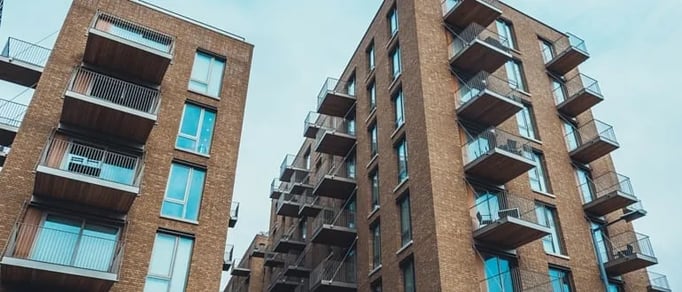4 min read
The 5 Most Common Profit-Killers In 40-Year-Old Multifamily Buildings
![]() David Schwartz
May 19, 2016 9:00:00 AM
David Schwartz
May 19, 2016 9:00:00 AM

Buying and owning a multi-family building can be a wonderful investment.
Especially, when you find a building requiring minimal fixes, in a great location, below market value. But as you know, “priced to sell” doesn’t always mean pounce! Any real estate investment will always be a calculated risk.
Even if you’ve done your due diligence—checking monthly and annual financial records, talking with past tenants, visiting the property various times a day unescorted etc.—you may still find yourself not turning as much of an initial profit as you’d hoped. Especially, when it comes to older buildings. But why not?
The precarious balance between replacing rundown components as they arise and charging tenants enough to make a nice profit.
Like any other business model, above-average success depends on providing the kind of value that “surprises and delights” customers.
But wait: Is it possible to create that kind of customer service experience in a 40-plus-year-old building (that doesn’t boast all of the amenities as the more expensive complex down the street)? The kind that turns tenants into loyal ambassadors who gladly speak your praises to their family and friends? We think so. And we also think you can take some really simple measures to cut costs along the way.
Here’s how to sidestep the most common “profit-killers” in old buildings:
Reduce water and electric bills
If you are one of the many owners who pays tenant water bills, you absolutely must hold routine inspections for leakage. If you’ve been facing unsightly water bills lately, you most likely have some unidentified leaks and drips.
A simple way to check for leakage is to do some meter surveillance. Just check the meters before and after a two-hour period when no water is being used. Obviously, you'll need to do this during hours when people typically aren't using water, like 2 or 3 am.
If your building meters do not read exactly the same, you probably have a leak. At which point, you’ll want to conduct a full-site inspection, which should include: All irrigation systems, radiators, shower heads, toilets and faucets.
Beyond repairing any leaks you find, you can also save drastically by installing tamper-proof low-flow fixtures on unit toilets, faucets and shower heads. Don’t let the initial expense put you off – you could save an average of $500 (per unit) the first year of doing so. Finally, you’ll want to begin replacing all lighting with energy-saving CFL and LED light bulbs designed to save you money.
As an added bonus, you won't need to replace them nearly as often. The average lifespan of CFLs is 8,000 hours and the average lifespan of LEDs is 50,000 hours, compared to a mere 1,200 hours with incandescent bulbs.
Challenge your property tax assessment
A real property tax assessment is a determination of a property’s tax class, assessed value, and eligibility for a full or partial exemption from tax. If you recently purchased a property substantially below its tax assessed value, it may be in your best interest to appeal the initial assessment. Though the process may take several months, the potential savings are worth the “red tape.”
How do you know if it's worth it? Estimate your property’s market value. Multiply your estimate by the assessment ratio for your property’s tax class. If the result is less than your property’s actual assessed value, you should strongly consider filing an application with your local Tax Commission. This one action could potentially offer thousands of dollars in annual savings.
Price shop your vendor contracts annually
You know how cable, phone, and Internet providers always seem to roll out the red carpet for new customers? Well, it’s sometimes the same with building vendors. Put simply, you don’t get what you don’t ask for.
Trash, landscaping, maintenance, and janitorial services should all be routinely evaluated for efficiency and price. For example, maybe your landscaper was one of a few in the area when you first moved in, but now (a mere 5 years later) there are several! Translation: Get out the phone book, go online, and ask around. You’ll be glad you did.
Plan for updates and rent increases
Obviously, the easiest way to increase profits is to raise rents. But, unless you’re experiencing a “temporary boom” in a place like Austin, Texas—where average rents have increased 25 percent over the past 5 years with very minimal updates—that's easier said than done.
You can't just raise prices for no reason; they have to be justified. Which means you must have a strategic plan for incremental upgrades. No matter your budget, you can begin transforming your older building into a more modern one right now:
Budget-Friendly Upgrades
- Exterior installation of fresh awnings
- An updated company logo and road sign
- Newly painted shutters & buildings (with modern colors)
- Fresh landscaping & the inclusion of community gardens
- Interior updates of cabinet fixtures, faucets, and shower heads
- Complimentary community programs (recycling, fitness, CSA drop-offs etc.)
Obviously, you’ll want to budget for more substantial upgrades as time goes on: Modern floors (ie. stained concretes or high-quality, laminate wood flooring), countertops, and appliances. The bottom-line is to have a plan for improvements and to continually be moving forward.
Go Above and Beyond
It's almost a given with an old building—something will break and someone will complain at some point. But how do you handle it?
Puruse any online apartment review forum and most of the complaints can be summed up in one word: Negligence. Tenants are upset because they don’t feel respected, acknowledged, and cared for. As a building owner, you know there are just some instances where repairs can not be done right away. Whether it’s a temporary shortage of staff or waiting on a needed part, delays sometimes occur.
But, owning an older building, you MUST develop a plan to minimize such instances as much as possible. Become known for having the fastest response time on those forums and tenants will overlook some of the shortfalls that come with living in an older building. Some things to consider:
- Create user-friendly, online ticketing systems for addressing tenant requests (study Amazon’s customer service process for inspiration).
- Set-up a 24-hour response policy that involves direct contact (communicate clear timelines and expectations upfront).
- Provide gift baskets, treats, and unexpected surprises in the event of major delays (i.e. gift cards to Redbox, Amazon, or Starbucks). Get creative; the sky's the limit.
As you know, owning and running a profitable building is no small task. But what separates those who “just do OK” from “those who do great” is pretty straight-forward:
- Paying attention to small financial details (from taxes to conservation).
- Committing to a sequential plan for building upgrades.
- Continually providing high-value customer service.


